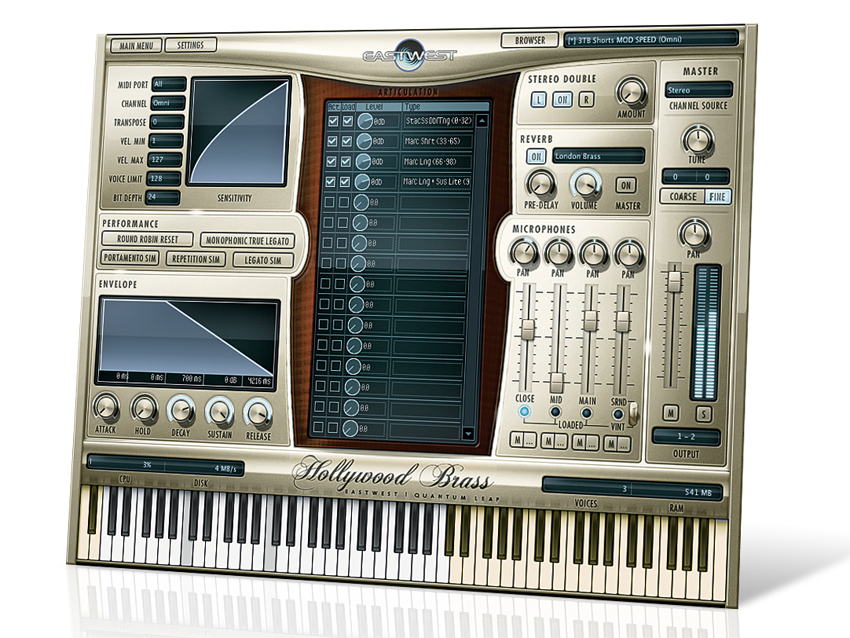MusicRadar Verdict
Hollywood Brass Diamond is quite possibly the ultimate professional solo/section brass ROMpler - hear it and weep.
Pros
- +
Excellent, consistent sound; good mix of solo and section patches; Play 3 is 64-bit on Mac and PC; great companion to Hollywood Strings; quality onboard convolution processor.
Cons
- -
No keyswitching patches; Gold edition only has one mic setup.
MusicRadar's got your back
EastWest's shift from straight-up sample libraries to its own ROMpler-style playback instrument (Play, now at v3) was a significant undertaking, and with teething problems resolved and 64-bit operation now in place, its grand scheme seems to have come to fruition.
The company has also started supplying its libraries on hard drives, enabling not only simple installation but also direct use from the provided disk; Hollywood Brass comes in two versions: Diamond ($995) and Gold ($595).
"EastWest's Studio 1's mid-sized, noninvasive ambience adds a lovely sense of space without getting in the way."
The main difference is that Diamond weighs in at 150GB and comes on a 3.5-inch internal hard drive, while the Gold Edition, at 20GB, ships on a set of DVDs. The reason for the size difference is that the Gold edition has considerably less content than Diamond, and lower audio fidelity - 16-bit, as opposed to Diamond's 24-bit.
The missing content comprises four of the five mic setups: Gold offers just one, the 'main' Decca Tree setting. On the upside, all of the articulations are included in Gold, so the transition should be seamless should you want to upgrade later. The cost of doing so is $349.
Diamonds are forever?
We're looking at the Diamond edition, which arrives on a 'bare' (ie, internal) drive. Like Hollywood Strings, it's aimed at soundtrack and mainstream musicians, and was produced in EastWest's Sunset Boulevard Studio 1.
The five mic configurations are also the same: main (Decca Tree), mid (Auditorium Front Row), close, and two rear (Surround and Vintage Ribbon) setups. You can mix and match up to four of these simultaneously (the surround mics are mutually exclusive). Instruments were recorded in standard orchestral position, the full stereo spectrum of which is captured by all but the close mics (these have matching manual panning).
The instruments comprise trumpet, French horn, trombone, tuba and cimbasso. All are available in solo patches, and then in a number of instrument-specific groupings. Maximum group sizes vary, from three trumpets to six horns, and you'll find the low brass is a combination group (two tenor trombones, one bass trombone, one tuba and one cimbasso).
Articulations include sustain, staccato, mute, legato and effects patches for pretty much all instruments. The available effects vary, but you can expect to find the typical rips, shakes, trills, crescendos and combinations thereof. You also get slide-heavy jazz effects for solo trombone.
Taming the horn
The Play 3 interface is straightforward, with an AHDSR amplitude envelope, convolution reverb, stereo spread control, velocity sensitivity and the mic mixer. There are also performance scripts for implementing portamento, repetition and legato.
The key to making the most of the instrument lies in understanding the patches. Each patch generally contains one articulation, with sustained styles looped at the end. However, patch behaviour does vary - checking out the manual is essential.
Some map velocity to timbre, others map the mod wheel to timbre, andsome use both. There are also patches in which the mod wheel gradually shifts between articulations, taking you from a very short sound to a more sustained one, for example.
Beyond the basics, patch naming often indicates further functionality, such as round robin inclusion. What you won't find, though, is velocity influencing volume (MIDI expression, CC#11, handles that), or keyswitching patches.
With all those mic options, RAM usage can stack up. Thankfully, patches load and unload mics as they're selected, so everything's kept as lean as possible.
Sonically, EastWest's Studio 1's mid-sized, noninvasive ambience is the same here as it is with Hollywood Strings, adding a lovely sense of space without getting in the way. For actual reverb, the onboard convolution effect offers plenty of useful and convincing spaces.
There's really nothing significant to complain about with Hollywood Brass, apart from the lack of keyswitching patches. The sampling is accurate and consistent, the patches are well organised and labelled, and it all sounds superb.
UPDATE: a free update is now available that adds keyswitches for every instrument in Hollywood Brass. You can download this from Soundsonline.
Computer Music magazine is the world’s best selling publication dedicated solely to making great music with your Mac or PC computer. Each issue it brings its lucky readers the best in cutting-edge tutorials, need-to-know, expert software reviews and even all the tools you actually need to make great music today, courtesy of our legendary CM Plugin Suite.

“This is a beautiful, well-executed Les Paul, and that’s the sort of guitar you tend to hold onto for life. That’s as sound an investment as there is”: Gibson Les Paul Standard ‘50s Double Trouble review

“We were able to fire up a bass sound that was indistinguishable from the flavour of New Order’s Blue Monday in seconds”: EastWest Sounds Iconic review

“How long did it take me to get over it? Oh, quite a while”: Brian May on the “supreme injustice” of Roger Taylor’s Queen B-side "making as much money as Bohemian Rhapsody"









